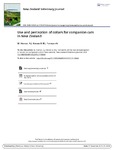Use and perception of collars for companion cats in New Zealand.
| dc.contributor.author | Harrod, M | en |
| dc.contributor.author | Keown, AJ | en |
| dc.contributor.author | Farnworth, MJ | en |
| dc.date.accessioned | 2018-08-13T14:00:20Z | |
| dc.date.available | 2018-08-13T14:00:20Z | |
| dc.date.issued | 2016-03 | en |
| dc.identifier.issn | 0048-0169 | en |
| dc.identifier.uri | http://hdl.handle.net/10026.1/12085 | |
| dc.description.abstract |
AIMS: To investigate the use and utility of collars for companion cats in New Zealand, and to explore public perception of collar use. METHODS: An online questionnaire was distributed using emails and social media to members of the general public in New Zealand. The questionnaire collected details of respondents, cat ownership status, and responses to a number of questions regarding collar use in cats. RESULTS: A total of 511 responses were collected. Of these, 393/511 (76.9%) reported owning ≥1 cat at the time of the survey, and 141/393 (35.9%) stated that ≥1 of their cats wore collars and 211/393 (53.7%) had ≥1 of their cats micro-chipped. Of the respondents with a pet cat, 351/393 (89.3%) allowed their cats some outdoor access. Respondents mainly used collars for identification and to reduce predation. Reasons for not using collars included cat intolerance of collars, repeated collar loss and concern over collar safety. Differences were found between cat owners and non-owners regarding whether they agreed that cats were important for pest control (43 vs. 25%, p<0.001); that not all cats will tolerate collars (81 vs. 64%, p<0.001); that cats should be kept indoors at night (37 vs. 58%, p<0.001); or disagreed that well fed cats will not catch birds (60 vs. 70%, p=0.04); and disagreed that a cat without a collar was likely to be a stray (85 vs. 76%, p<0.001). Respondents most trusted veterinarians and the Society for the Prevention of Cruelty to Animals as sources of pet care information. CONCLUSIONS: Collar use within this sample of cat owners in New Zealand appeared to be low, with more using microchips for identification. The majority of cat owners in this study indicated their cats had some outdoor access, with collars being used for cat identification and to reduce hunting behaviour. Significant differences existed in opinions on cat management between cat owners and non-owners in this study. It should be noted that this preliminary exploration was based on a self-selected group of respondents and so results and conclusions cannot be extrapolated to the wider population. RELEVANCE: As the most trusted source of information about pet care, an enhanced understanding of cat ownership and management may be of use to veterinarians to promote responsible pet ownership and to develop national policies and practices to improve cat welfare. | en |
| dc.format.extent | 121 - 124 | en |
| dc.language | eng | en |
| dc.language.iso | eng | en |
| dc.subject | Animal welfare | en |
| dc.subject | cat | en |
| dc.subject | collar | en |
| dc.subject | identification | en |
| dc.subject | veterinary services | en |
| dc.subject | Animal Welfare | en |
| dc.subject | Animals | en |
| dc.subject | Cats | en |
| dc.subject | Humans | en |
| dc.subject | New Zealand | en |
| dc.subject | Ownership | en |
| dc.subject | Pets | en |
| dc.title | Use and perception of collars for companion cats in New Zealand. | en |
| dc.type | Journal Article | |
| plymouth.author-url | https://www.ncbi.nlm.nih.gov/pubmed/26539622 | en |
| plymouth.issue | 2 | en |
| plymouth.volume | 64 | en |
| plymouth.publication-status | Published | en |
| plymouth.journal | N Z Vet J | en |
| dc.identifier.doi | 10.1080/00480169.2015.1110064 | en |
| plymouth.organisational-group | /Plymouth | |
| dc.publisher.place | England | en |
| dc.rights.embargoperiod | Not known | en |
| rioxxterms.versionofrecord | 10.1080/00480169.2015.1110064 | en |
| rioxxterms.licenseref.uri | http://www.rioxx.net/licenses/all-rights-reserved | en |
| rioxxterms.type | Journal Article/Review | en |


